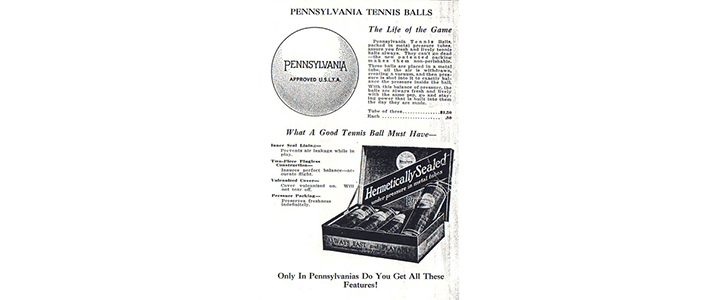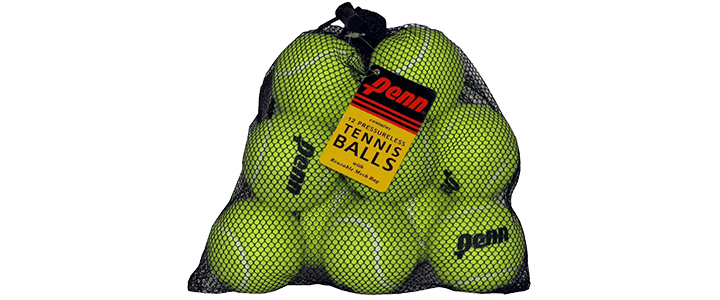Check out my custom vibration dampener
Penn Tennis Balls
Definitive Product & Buyer’s Guide
We hope you love this article. Just so you know, TennisCompanion may collect a small share of sales from the links on this page to help keep this site running. Learn more.
With over a hundred years of manufacturing under its belt, Penn is one of the most recognizable brands in tennis, developing a range of quality tennis balls designed to suit a variety of player preferences.
If you’re on the hunt for a fresh set of balls, Penn is a company you can trust, with most undergoing stringent International Tennis Federation (ITF) testing and approval. However, with Penn offering several balls that showcase differing characteristics, it may not be readily apparent which are best for your needs.
This guide aims to help you select the right balls by providing practical advice, a detailed breakdown of Penn’s offerings, and straightforward descriptions of each product. I’ll kick things off with some brief background on the company’s history and insight into its manufacturing process for those who like to nerd out as I do.
| Ball | Type | Player |
| Penn Tour | Pressurized | Adult |
| Pro Penn Marathon | Pressurized | Adult |
| Pen Championship | Pressurized | Adult |
| Penn Titanium | Pressurized | Adult |
| Penn Court 1 | Pressurized | Adult |
| Penn Coach | Pressurized | Adult |
| Penn Pressureless | Pressureless | Adult |
| Penn QST 36 Foam / Red Stage 1 | Pressureless | Kids |
| Penn QST 36 Felt / Red Stage 2 | Pressurized | Kids |
| Penn QST 60 / Orange Stage | Pressurized | Kids |
| Penn Control+ / Green Stage | Pressurized | Kids |
Article Contents
Click below to jump to a section
Tap below to jump to a section
About Penn
How Penn Balls Are Made
Types of Penn Balls
Regular vs. Extra-Duty
Penn’s Ball Lineup
How to Choos a Ball
New to TennisCompanion?
Create a free account and explore my latest videos below
About Penn

Although Penn is one of the most recognizable names in tennis, the company’s origin story isn’t widely known by tennis players.
Originally founded in 1899 by Herbert DuPay in Erie, Pennsylvania, the Pennsylvania Rubber Company started by creating various goods outside the sporting sector, including tires, valves, and fruit jar rings, before taking the leap to make its first tennis balls in 1910.

By then, the company had relocated to Jannette, Pennsylvania, where they’d manufacture all of their balls, and production was off to a healthy start from the beginning. In their first year, they produced an impressive 13,000 handmade tennis balls, averaging about 36 per day, roughly what their modern plants now make per hour.
Initially, the Pennsylvania Rubber Company didn’t can their balls, instead selling them “fresh,” so the balls didn’t last very long. However, that changed in 1922 when the company introduced hermetically sealed metal cans that were air-tight, preventing the balls from losing pressure.

For years, the company only produced white tennis balls, which were standard at the time, along with the color black. However, in 1968 they created their first fluorescent yellow tennis balls, a color the ITF eventually embraced in 1974 for better visibility on color TV screens which had started to become mainstream.
Early on, the company branded its balls as Pennsylvania tennis balls, and it wasn’t until the 1970s that it adopted the abbreviated name, Penn.
In 1999, Head acquired Penn, which is currently headquartered in Phoenix, Arizona. These days, Penn doesn’t manufacture their balls in the United States as it did when it first started. Instead, they make all of them in China, Thailand, and Argentina.
How Penn Balls are Made
On the surface, a tennis ball doesn’t necessarily seem like an overly complicated product to create. However, dig a little deeper, and you’d be surprised to learn that the assembly line for balls is nothing short of an engineering marvel producing millions of tennis balls annually.
The process involves 16 steps and a combination of high-quality raw materials, precision equipment, and manual labor to churn out balls that meet stringent criteria necessary for approval by the ITF.
To gain an appreciation for the steps involved in manufacturing Penn tennis balls, I’d encourage you to check out the video published by the company in January 2012. It’s a fun watch.
Although the company has undoubtedly improved its production process in the past 20 years, the essence remains the same.
Types of Penn Balls
At first glance, all tennis balls from Penn look similar. However, despite their likenesses in appearance, they’re not all the same. From a broad point of view, we can categorize Penn’s balls into three buckets: pressurized, pressureless, and high altitude.
Understanding each type of ball and its purpose will help you narrow down and select the best ball for your needs.
Pressurized

A pressurized tennis ball is the most common, which you’ll find used at all levels of play, from recreational to professional.
These typically come in a plastic can or tube that Penn pressurizes with a mix of air and nitrogen to maintain freshness. Due to their pressurized nature, they offer the best performance in bounce and feel.
However, their longevity is poor because they lose pressure over time, meaning you must replace them regularly. Depending on how frequently and aggressively you play, mileage will vary. Generally, you shouldn’t expect an open can of tennis balls to last longer than a week or two.
Helpful Tip
To help improve the lifetime of a pressurized ball, you can invest in an inexpensive tennis ball saver. After playing with a new can of tennis balls, pop them into the tennis ball saver. Then, twist it shut to increase the container’s pressure to 14 PSI, the same amount used to pressurize the balls initially, thus, helping maintain their freshness.
Pressureless

Unlike pressurized tennis balls, pressureless balls aren’t canned or stored with internal pressure. Instead, they use a thicker rubber compound that provides adequate bounce without needing to be pressurized.
As a result, Penn doesn’t sell their pressureless tennis balls in sealed cans. Instead, you’ll find them in buckets, boxes, or mesh bags.
Their most redeeming quality is their longevity, but they also tend to be more durable than their pressurized counterparts. Regarding performance, they’re not quite as lively as pressurized balls, and they’re firmer, so tournaments rarely use them in competition.
However, they’re ideal for practice or recreational players who don’t regularly hit because they stay fresh for considerably longer. Likewise, players who don’t demand the best performance each time they hit the court will be more than satisfied with this type of ball.
When opting for pressureless balls, I’d encourage you to select a premium option rather than settling for an inexpensive ball. Since they have a greater lifespan, spending more upfront will ensure you have the best performance over the long haul.
High Altitude

At lower altitudes, a standard pressureless ball bounces perfectly for the environment. However, these balls have a significantly greater bounce at higher altitudes, making them unplayable.
To accommodate, some manufacturers have created high-altitude tennis balls where the internal pressure is less than a standard ball so that the bounce is more appropriate for the elevation.
According to the ITF, high-altitude tennis balls are ideal for play at elevations above 4,000 ft (1,219 m). However, you may find they’re well-suited for slightly lower altitudes. If you live between two and three thousand feet, ask your local pro shop or tennis club what they’re using to gain a feel for what’s best for your location.
Regular vs. Extra-Duty

When searching for a can of Penn tennis balls, you’ll likely stumble across some with regular duty felt and others with extra duty felt.
Regularly duty felt is thinner and more tightly woven, ideal for softer courts, including clay, grass, and carpet. They’re less durable and play faster because they’re more aerodynamic and less prone to debris getting stuck in the more tightly woven felt on clay courts.
Extra duty felt is thicker and more loosely woven, which makes them ideal for hard courts. They’re more durable, play slower, and make it easier to generate topspin as the strings on your racquet grip them better.
With those general guidelines in mind, it all boils down to personal preference – you can use either ball on any court. There are no rules on this front. More broadly, extra-duty felt tennis balls are the most popular.
Regular vs. Extra-Duty on The Pro Tour
Using regular vs. extra-duty tennis balls has sparked controversy on the pro tour. Notably, the US Open uses regular-duty tennis balls for the women’s tournament and extra-duty tennis balls for the men’s.
According to the USTA, they consult with the WTA annually before determining what ball to use. For years, they agreed upon regular duty balls, which are easier on a player’s arm, but some players, including Iga Swiatek, have publicly claimed they prefer extra duty.
There isn’t a consensus among players on the WTA tour on which is better, so this will likely remain a point of contention for future years.
Penn’s Ball Lineup
Penn sells twelve different tennis balls, some with multiple variations. This section breaks down each and describes their ideal usage so you can decide which ones are best for your needs.
Before jumping in, here’s a table outlining what to expect from Penn’s entire line of tennis balls.
Type 2 tennis balls are the most common, which adhere to specific criteria outlined by the ITF ball approval procedures.
Premium
Penn’s premium tennis balls are ideal for players who demand the best performance for competitive play.
Penn Tour

Penn’s Tour tennis balls are one of their premium offerings and the only ball from their lineup that has found its way into ATP tournament use.
These balls are ITF-approved and feature LongPlay felt for extra durability and longer-lasting play. Penn also treats this ball with Smart Optik for 19% greater visibility than a standard ball.
If you’re looking for the best ball from Penn, look no further, as these are as good as they come. They’re lively and offer an excellent feel and a consistent bounce for exceptional all-around performance.
Although you’ll spend a little extra for the Penn Tour, they’re perfectly well-suited for all levels of play. If you’re just getting started with tennis and this is all that’s available to you, or you’re curious to try them, then, by all means, go for it.
Penn’s Tour tennis balls come in three and four-ball cans with regular-duty felt for softer courts and extra-duty felt for hard courts. The extra-duty high-altitude variation only comes in three-ball cans and is ideal for play at elevations above 4,000 ft (1,219 m).
Variations
- Penn Tour Regular Duty
- Penn Tour Extra Duty
- Penn Tour Extra Duty High Altitude
Pro Penn Marathon

Like Penn’s Tour tennis balls, the Pro Penn Marathon are premium tennis balls and some of the best they offer. However, these balls stand out by incorporating Penn’s Encore technology, increasing their durability, which they pair with LongPlay felt to improve the overall longevity of the ball’s performance.
I’ve found these balls to perform well, and while I agree with their added durability for longer-lasting play, they’re a bit stiffer than the Tour due to their slightly thicker rubber cores. For that reason, I like the Tour better, but if you’re looking to get a bit more life out of your balls, then the Pro Penn Marathon is an excellent option.
For an even longer-lasting performance, I’d encourage you to use the Pro Penn Marathon with a tennis ball saver because I find that these balls lose their bounce well before they’re ready to be tossed.
The Pro Penn Marathon tennis balls come in three-ball cans with regular-duty felt for softer courts and extra-duty felt for hard courts. The extra-duty high-altitude variation is ideal for play at elevations above 4,000 ft (1,219 m).
Variations
- Pro Penn Marathon Regular Duty
- Pro Penn Marathon Extra Duty
- Pro Penn Marathon Extra Duty High Altitude
Championship
Penn’s Championship tennis balls are a well-rounded line that strikes a balance between performance and cost for a wide range of players.
Penn Championship

Out of all of the company’s offerings, Penn Championship tennis balls are the most ubiquitous because of their price point and reliable performance. In the US, they’re the number one selling tennis ball and the official ball of the USTA leagues.
The felt isn’t the most durable, and they don’t last as long as Penn’s premium offerings, but they’re a quality tennis ball that delivers reliable performance for a wide range of settings.
As a result, I highly recommend these for recreational and competitive play. Likewise, if you’re a beginner unsure of what balls to use, these are an excellent option for getting started.
Players who prefer pressurized tennis balls and enjoy cracking a fresh can each time they play will do well with Penn Championship, as they’re relatively easy to find in bulk at stores like Costco for a reasonable price.
Penn Championship tennis balls come in three-ball cans with regular-duty felt for softer courts and extra-duty felt for hard courts. The extra-duty high-altitude variation is ideal for play at elevations above 4,000 ft (1,219 m). Penn also has a pink variation of their Championship tennis balls to support breast cancer research by donating $.15 for every can sold.
Variations
- Penn Championship Regular Duty
- Penn Championship Extra Duty
- Penn Championship Extra Duty in Pink
- Penn Championship Extra Duty High Altitude
Penn Titanium

A unique offering from Penn, their Titanium tennis balls offer some of the greatest durability with a rubber core that integrates titanium and a thicker grade of felt that improves longevity.
Like the Pro Penn Marathon, I’ve found these balls to go dead well before their felt or rubber core wears down, so although they’re more durable, you’ll be hard-pressed to get the maximum life out of them unless you’re storing them in a tennis ball saver.
Another point to keep in mind is that these balls play noticeably firmer, so if you’ve suffered from any arm injuries or have preexisting discomfort, I’d encourage you to stay away from them.
Penn’s Titanium balls only come in three-ball cans with extra-duty felt, which is ideal for hard courts.
Recreational
Penn’s recreational balls are budget-friendly and perfect for recreational play, practice, or coaching. These balls are not ITF-approved.
Penn Court 1

A step down from Penn’s Championship line, Penn Court One tennis balls are ideal for casual recreational play, but I wouldn’t recommend them for competition.
Their overall performance and durability are sufficient to hit the court with, but their bounce isn’t quite as consistent. Furthermore, they often feature imperfections and don’t last as long.
With that said, these differences will be negligible for beginners and those who hit the court infrequently or purely to get some exercise periodically.
Penn Court One tennis balls are available in three-ball cans with less durable regular-duty felt.
Penn Coach

Some balls that come off Penn’s assembly line have minor cosmetic imperfections that aren’t quite up to the standards for selling under their core brand names, including Tour, Marathon, and Championship.
However, despite the blemishes, these balls are not unusable, so Penn markets them to coaches who regularly fill large baskets of tennis balls that they feed students during instruction.
In this scenario, coaches aren’t always looking for perfect tennis balls. Instead, they’re looking for affordable options that they can reliably use for instruction where repetition is essential.
That’s where Penn Coach tennis balls come into play. If you don’t mind the blemishes, you might also give them a try to save some money, just don’t expect them to be Penn’s highest-quality product.
Penn Coach tennis balls come in three-ball cans.
Pressureless
Penn’s pressureless tennis balls are ideal for players who are tired of their balls dying too quickly and constantly spending money on new ones.
Penn Pressureless

Penn’s Pressureless tennis balls don’t have internal pressure like their standard pressurized balls, which means they’ll last significantly longer.
In most cases, you won’t get more than two weeks out of a pressurized ball, but with these, you can get several months out of them. Instead of the balls dying due to lack of internal pressure, you’ll monitor their felt more closely than anything for replacement, which becomes compacted or prone to tears, resulting in poor performance.
Initially, Penn’s pressureless balls tend to be firmer with a slight break-in period. Once you hit with them a few times, the rubber will soften, and their performance will improve.
You’ll also find that these balls travel a bit slower and aren’t quite as lively as their pressurized counterparts, making them ideal for new players learning how to play the game for the first time.
Since they don’t need to be pressurized, you’ll find Penn selling their pressureless balls in mesh bags, boxes without cans, and buckets.
Kids
In the US and many other countries worldwide, organizations like the USTA have adopted programs for kids that teach them with unique equipment and smaller court sizes to make the game more approachable.
One element of tennis gear that caters to younger kids is the tennis balls – Penn offers four options for ten and under tennis.
| Stage | Color | Material | Size | Compression |
| Red Stage 1 | Red & Yellow | Foam | Largest | None |
| Red Stage 2 | Red & Yellow | Rubber & Felt | 15% larger than standard | 25% of standard |
| Orange | Orange & Yellow | Rubber & Felt | Standard | 50% of standard |
| Green | Green & Yellow | Rubber & Felt | Standard | 75% of standard |
Penn QST 36 Foam (Red Stage 1 – Cut foam)

When kids first learn to play tennis at a younger age, they’ll start with larger foam tennis balls that are easy targets and soft to the touch to prevent injury.
Penn’s QST 26 foam tennis balls are ideal for kids eight or younger learning on a 36′ tennis court. They offer plenty of spring when hitting and a gentle bounce that helps to flatten the learning curve for kids.
Because they’re foam, they catch the wind easier, so they’re ideal for indoor play, but that doesn’t mean kids can’t use them outside, especially when the conditions permit.
These balls come in packs of two, three, or bulk and are the only kids’ balls that are not pressurized.
Penn QST 36 (Red Stage 2 – Standard Construction)

Once children develop hand-eye coordination and the ability to hit with red foam balls, they’ll eventually graduate to red felt balls like Penn’s QST 36 balls.
Similar to the QST 26 foam balls, these are ideal for kids eight or younger learning to play on a 36′ tennis court. They’re the same size and have a rubber core and a felt cover like standard tennis balls, but their compression is 25% of a regular ball. The result is a lower bounce and slower play, which is ideal for kids learning how to play tennis.
Designed for red stage 2, the Penn QST 36 lower-pressure red and yellow tennis balls come in packs of three or bulk.
Penn QST 60 (Orange Stage)

Kids graduating from red stage 2 to the orange stage will begin using orange and yellow balls with the same dimensions as a standard ball with 50% compression.
Penn designs their QST 60 balls for kids ages 9 and 10 playing on a 60′ tennis court. Their lower compression results in lower bounces that better align with the height of kids at this age. However, they still offer plenty of bounce for extended rallies as children learn to improve control.
Like the QST 36 felt tennis balls, the Penn QST 60 tennis balls come in packs of three or bulk for orange stage ten and under tennis.
Penn Control+ (Green Dot)

Before transitioning to standard tennis balls, kids will first use a ball with 75% compression.
The Penn Control+ tennis balls are for kids nine or older playing on a standard 78′ court. They play mildly slower than a regular ball and are an excellent stepping stone for kids reaching the green stage.
The Penn Control+ are the only kids’ tennis balls that come in a pressurized can to retain their freshness. However, you can also purchase unpressurized bags in bulk.
Novelty
Great for signatures and decorations, Penn’s novelty tennis balls are not for use playing tennis, but kids (and dogs) will love them.
Giant Penn Ball

If you’ve ever attended an ATP or WTA tennis tournament or watched one on TV, you’ve likely seen kids toting around oversized tennis balls.
Most parents buy giant tennis balls for their kids to attempt to get players’ signatures at professional tournaments, but they also make great decorations and are fun toys for dogs.
Penn’s giant tennis balls are not pressurized or intended for playing tennis, although I wouldn’t blame you for being tempted to try hitting with one on a court.
How to Choose a Ball
There are a few simple questions I’d encourage you to ask yourself that will help make finding your next can of Penn tennis balls easier.
Are you playing at a higher elevation?
If you’re playing at an altitude above 4,000 ft (1,219 m), there are only three Penn Balls to consider.
- Penn Tour Extra Duty High Altitude
- Pro Penn Marathon Extra Duty High Altitude
- Penn Championship Extra Duty High Altitude
If you’re unsure which option to select, start with Penn Championship. They’re the least expensive and a quality ball that won’t disappoint, especially if you’re new to the game.
If you’re playing competitive tennis and haven’t tried Penn Tour or Penn Pro Marathon, my first recommendation would be Penn Tour, which has a more typical feel paired with premium performance.
Although I don’t mind Pro Penn Marathon, they’re a bit stiffer, and I don’t find the added durability to make all that much difference because, as pressurized balls, they’re subject to die just as soon as the Tours.
All these balls are extra-duty, so you don’t have to consider that factor.
What type of court are you playing?
If you’re playing on clay, carpet, or lucky enough to play on grass, then a good starting point for a can of Penn tennis balls will be regular-duty balls, which are ideal for softer courts. In that case, here are your options.
- Penn Tour Regular Duty
- Pro Penn Marathon Regular Duty
- Penn Championship Regular Duty
Extra-duty balls will be your best bet for added durability if you play on hard courts.
- Penn Tour Extra Duty
- Pro Penn Marathon Extra Duty
- Penn Championship Extra Duty
Unless you’re tired of buying balls repeatedly because they die too quickly, in that case, I’d encourage you to try Penn’s pressureless balls.
- Penn Pressureless Balls
Most casual or recreational players I talk with find pressureless balls a great option because they’re always playable. Even if they sit in your garage all winter, they’ll be ready to use come next spring. Ultimately, considering the type of surface you’re playing on will ensure you get the ideal balls for the job.
What’s your skill level?
If you’re a beginner, spending extra money on tennis balls when first starting isn’t necessary. You’ll be hard-pressed to tell the difference, so you’ll be better off selecting the more affordable options and graduating to a premium can later. These include:
- Penn Championship Regular Duty
- Penn Championship Extra Duty
- Penn Court One
Penn’s pressureless balls are also a worthy option for beginners because they’ll play a little slower and last a long time, reducing the cost of paying for balls.
- Penn Pressureless
As your skills improve, Penn Championship balls will remain an excellent option. However, if you’re playing a match or competitive tennis, I’d encourage you to give Penn’s Tour tennis balls a shot.
At this stage, you should be able to tell the difference, which you’ll likely appreciate. I’m not a huge fan of the stiffer feel for Penn’s Pro Marathon balls, so those would be my last choice.
- Penn Tour Regularly Duty
- Penn Tour Extra Duty
- Pro Pen Marathon Regular Duty
- Pro Penn Marathon Extra Duty
Either way, it’s a relatively inexpensive experiment to try both of them, so I’d give each a shot to gain a feel for what you prefer.
Are you a coach?
Any of these balls will make great companions for the court if you’re a coach. However, if you’re working by yourself and paying for your balls, then Penn’s Coach balls or pressureless will be your best bet to save the most money in the long run.
Wrapping Up
Overall, selecting the right Penn tennis ball boils down to personal preference, so you’ll need to give each of them a shot to see which you like.
Hopefully, as you explore your options and weigh the pros and cons, my notes have helped provide you with some practical guidance.
Home > Gear > Accessories > Penn Tennis Balls
Play Better Tennis
Improve your game alongside our community of tennis players
Why join?
Discussion Boards
Join the conversation with other members of the community.
5 Point Friday
Read our weekly recap of the 5 most interesting things we dig up in tennis.



Leave a Reply
Want to join the discussion?Feel free to contribute!